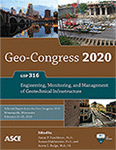Geo-Congress 2020
Multi Hazard Analysis of Earth Slopes Using Coupled Geotechnical-Hydrological Finite Element Model
Publication: Geo-Congress 2020: Engineering, Monitoring, and Management of Geotechnical Infrastructure (GSP 316)
ABSTRACT
The purpose of this study is to analyze the stability and deformation behaviors of earth slopes subjected to common natural hazards such as rainfall, toe erosion induced by the flood, earthquake, and simultaneous occurrence of rainfall-erosion and rainfall-earthquake. A coupled geotechnical-hydrological finite element software, PLAXIS 2D which is capable of coupling deformation and flow behavior of soil with varying degree of saturation was used. First, a two-dimensional (2D) plane strain model was analyzed by applying a single hazard: rainfall, toe erosion induced by the flood, and earthquake and then dual hazards: rainfall-erosion and rainfall-earthquake. The results showed that slope movements due to dual hazard were higher compared to a single hazard. The factor of safety against slope stability from the dual hazard analysis was found to be lower than that of single hazard analysis. The percentage decrease in the factor of safety for the dual hazard rainfall-erosion compared to single hazard rainfall is 16.1% for SR1, 19.7% for SR2, and 17.3% for SR3. Further, from the parametric study, it can be observed that the factor of safety for the slope ratio 2:1 is 27.67% larger than the slope ratio 1.5:1 and for the slope ratio 3:1 is 78.05% larger than the slope ratio 1.5:1.
Get full access to this article
View all available purchase options and get full access to this chapter.
REFERENCE
Chen, R. H., Chen, H. P., Chen, K. S., and Zhung, H. B. (2009). “Simulation of a slope failure induced by rainfall infiltration,” Environmental Geology, 58, 943-952.
Evans, S. G., Guthrie, R. H., Roberts, N. J., and Bishop, N. F. (2007). “The disastrous 17 February 2006 rockslide-debris avalanche on Leyte Island, Philippines: a catastrophic landslide in tropical mountain terrain,” Natural Hazards and Earth System Sciences, 7(1), 89-101.
Fredlund, D.G., Morgenstern, N. R., and Widger, R. A. (1978) “Shear strength of unsaturated soils,” Canadian Geotechnical Journal, 15(3), 313-321
Jemec, M., and Komac, M. (2013). “Rainfall patterns for shallow land sliding in perialpine,” Natural Hazards, 67(3), 1011-1023.
Keefer, D.K., (1984a). “Landslides caused by earthquakes,” Geological Society of America Bulletin, 95, 406–421.
Nakamura, S., Wakai, A., Umemura, J., Sugimoto, H., and Toshiya, T. (2014). “Earthquake-induced landslides: Distribution, motion and mechanisms,” Soils and Foundations, 54(4), 544-559.
PLAXIS, PLAXIS 2D reference manual; 2018
Robinson, J. D., Vahedifard, F., and AghaKouchak, A. (2017). “Rainfall-triggered slope instabilities under a changing climate: comparative study using historical and projected precipitation extremes,” Canadian Geotechnical Journal, 54(1), 117-127.
Sanchez, A. (2013). “Albuquerque rainfall breaks record from 1929”, AlbuquerqueJournal. [online] Abqjournal.com. Available at: https://www.abqjournal.com/264020/rain-keeps-pouring-on-new-mexico.html.
Tang, L., and Chen, G. (1997). “The dynamic model of water and soil generated in small water shed,” Journal of Hydrodynamics, Serials A, 12(2), 164-174
Vanapalli, S. K., Fredlund, D.G., Pufahl, D.E., and Clifton, A.W. (1996). “Model for the prediction of shear strength with respect to soil suction,” Canadian Geotechnical Journal, 33(3), 379-392.
van Genuchten, M.Th. (1980). “A closed-form equation for predicting the hydraulic conductivity of unsaturated soils,” Soil Science Society of American Journal, 44(5), 892-898.
Yang, S., Lohnes, R.A., and Kjartanson, B.H. (2002). “Mechanical Properties of Shredded Tires,”GeotechnicalTesting Journal, GTJODJ, 25 (1), 44-52.
Youwai, S., and Bergado, D.T.(2003). “Strength and deformation characteristics of shredded rubber tire-sand mixtures,” Canadian Geotechnical Journal, 40(2), 254-64.
Zêzere, J. L., Trigo, R. M., and Trigo, I. F. (2005). “Shallow and deep landslides induced by rainfall in the Lisbon region (Portugal): assessment of relationships with the North Atlantic Oscillation,” Natural Hazards and Earth System Science, 5(3), 331-344.
Zingg, A. W. (1940). “Degree and length of land slope as it affects soil loss in runoff,” Agric. Engng, 21, 59-64.
Information & Authors
Information
Published In
Geo-Congress 2020: Engineering, Monitoring, and Management of Geotechnical Infrastructure (GSP 316)
Pages: 60 - 69
Editors: James P. Hambleton, Ph.D., Northwestern University, Roman Makhnenko, Ph.D., University of Illinois at Urbana-Champaign, and Aaron S. Budge, Ph.D., Minnesota State University, Mankato
ISBN (Online): 978-0-7844-8279-7
Copyright
© 2020 American Society of Civil Engineers.
History
Published online: Feb 21, 2020
ASCE Technical Topics:
- Climates
- Coupling
- Disaster risk management
- Disasters and hazards
- Engineering fundamentals
- Environmental engineering
- Finite element method
- Geohazards
- Geomechanics
- Geotechnical engineering
- Geotechnical models
- Meteorology
- Methodology (by type)
- Models (by type)
- Natural disasters
- Numerical methods
- Precipitation
- Rainfall
- Slope stability
- Slopes
- Structural engineering
- Structural members
- Structural systems
Authors
Metrics & Citations
Metrics
Citations
Download citation
If you have the appropriate software installed, you can download article citation data to the citation manager of your choice. Simply select your manager software from the list below and click Download.
